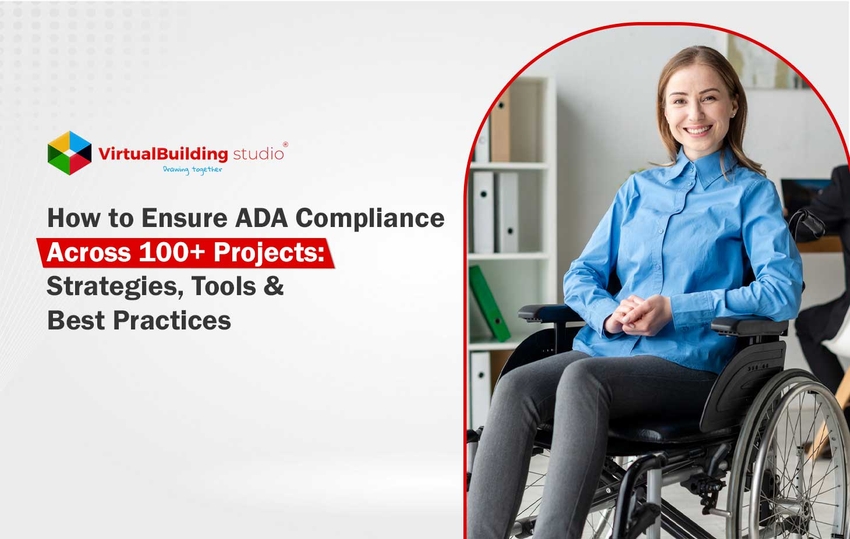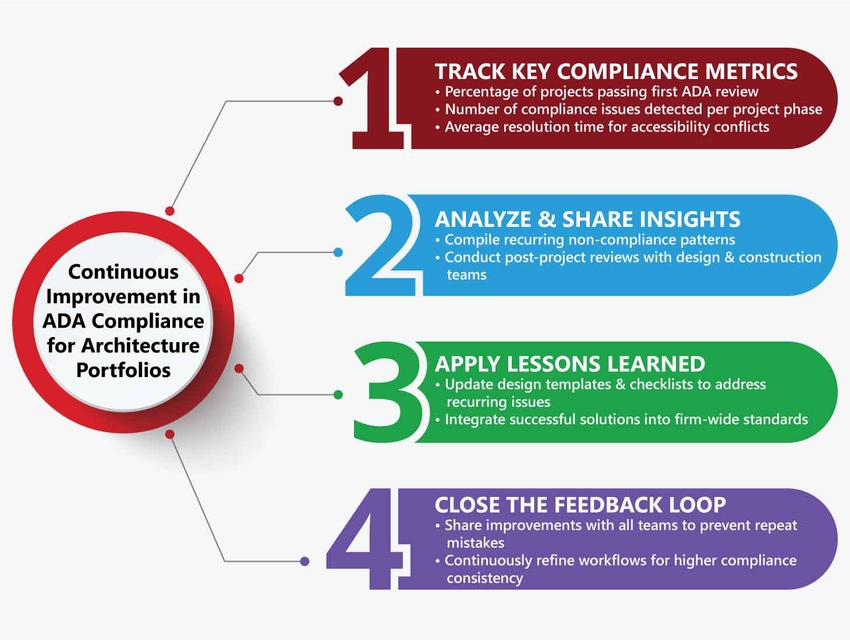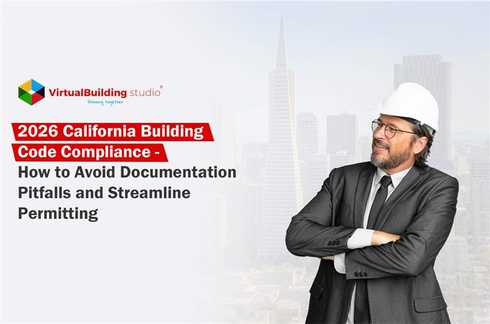
Scaling ADA Compliance for Large-Portfolio Architecture Firms
The Americans with Disabilities Act (ADA) sets the legal framework for ensuring equal access to public spaces, facilities, and services for individuals with disabilities. In the architecture, engineering, and construction (AEC) industry, ADA compliance means integrating accessibility standards into every phase of project delivery, covering elements such as ramps, clearances, tactile signage, and restroom layouts.
Today, ADA compliance extends beyond physical spaces to include digital accessibility for building-related systems and interfaces, making it non-negotiable in both design and operations. For large architecture firms managing 100+ projects annually, the challenge lies in:
- Navigating varying federal, state, and local accessibility requirements
- Maintaining design consistency across geographically dispersed projects
- Preventing costly retrofits caused by late-stage non-compliance discoveries
This blog explores systematic, scalable approaches, including standardized templates, technology integration, and centralized review processes, to help large-scale firms enforce ADA compliance efficiently across an entire project portfolio.
Understanding ADA Compliance in Construction & Design
ADA compliance in the AEC industry is more than meeting a checklist—it’s about embedding accessibility into the DNA of every project. The ADA Standards for Accessible Design outline technical criteria that ensure buildings and facilities are usable by individuals with a wide range of physical and sensory abilities.
Key Accessibility Requirements in Design
- Accessible routes: Continuous, unobstructed paths with compliant slopes, widths, and landings.
- Doorways & clearances: Minimum clear opening widths, handle heights, and maneuvering spaces.
- Restroom accessibility: Grab bar positioning, turning radii, fixture heights, and stall dimensions.
- Tactile & braille signage: Placement, font, and contrast to meet ADA visibility standards.
- Ramps & curb cuts: Slope gradients, surface textures, and edge protection.
Applicable Codes & Standards
- ADA Standards for Accessible Design (U.S. Department of Justice) – Federal baseline.
- ICC/ANSI A117.1 – Technical specifications for accessibility in building design.
Federal vs. Local Variations:
While the ADA sets nationwide requirements, states and municipalities may have stricter or supplemental rules. Architecture firms must reconcile these differences early in the design phase to avoid conflicts, delays, or rework, especially in multi-state project rollouts.
A deep understanding of these nuances is essential for ensuring compliance at scale without compromising design quality or project timelines.
Challenges of Enforcing ADA Compliance Across 100+ Projects Annually
For architecture firms managing large-scale portfolios, ensuring ADA compliance across dozens or even hundreds of projects each year is a complex operational challenge. The scale magnifies the risk of inconsistencies, overlooked requirements, and costly late-stage corrections.
Key Challenges of Enforcing ADA Compliance Include
- Variations in Local Codes & Interpretations: While ADA Standards provide a federal baseline, states and municipalities often impose additional requirements or adopt unique interpretations. A detail that passes review in one jurisdiction might trigger revisions in another.
- Multi-Team & Multi-Partner Coordination: Large projects often involve multiple design teams, consultants, and contractors. Without centralized oversight, ADA compliance can become fragmented, leading to misaligned deliverables.
- Keeping Up with Regulation Updates: Accessibility standards evolve over time. Ensuring all stakeholders, across offices and regions, are up to date requires structured training and information sharing.
- Time & Budget Pressures: Fast-paced rollout schedules, especially in retail, hospitality, or public infrastructure, leave little room for rework. Even minor compliance oversights can derail timelines and inflate costs.
Addressing these challenges demands a systematic, portfolio-wide compliance framework—supported by standardized processes, real-time communication, and integrated technology—to maintain consistency without slowing delivery.
Proven Strategies for Scalable ADA Compliance
Managing ADA compliance across a large project portfolio requires more than just awareness—it calls for standardized, technology-enabled, and process-driven solutions. The following strategies help architecture firms maintain consistency, reduce risk, and streamline compliance efforts at scale.
Standardized Design Templates & Detail Libraries
- Develop pre-approved CAD/BIM templates containing ADA-compliant details for door clearances, restroom layouts, ramp designs, and signage.
- Maintain a central repository accessible to all design teams, ensuring consistency across projects and reducing repetitive design checks.
- Incorporate jurisdiction-specific variations into adaptable template versions.
ADA Compliance Checklists
- Create project-phase-specific checklists, covering schematic design, design development, construction documents, and as-built stages.
- Use these checklists as mandatory sign-off tools before advancing to the next project milestone.
- Include both federal ADA requirements and state/local amendments to avoid mid-project surprises.
Dedicated Accessibility Review Teams
- Centralize compliance expertise within a specialized internal review group or retained consultants.
- Have this team perform pre-submission reviews to catch issues before drawings reach permitting or construction.
- Serve as a knowledge hub for interpreting ambiguous code language or resolving conflicts between jurisdictions.
Regular ADA Training & Updates for Staff
- Conduct quarterly or semi-annual training sessions for architects, engineers, and site supervisors.
- Provide regulation update briefings whenever ADA standards or local codes change.
- Integrate ADA training into new employee onboarding to embed compliance awareness from day one.
Technology Integration
- BIM-based Accessibility Checks: Use parametric modeling to enforce ADA dimensions and flag violations automatically.
- Automated Code-Checking Software: Deploy tools like Solibri, Navisworks, or other compliance-checking platforms to cross-reference models with ADA standards.
- Enable real-time model validation so errors are caught during design, not post-construction.
By combining standardization, central oversight, continuous education, and smart technology, architecture firms can create a scalable ADA compliance framework. This approach minimizes rework, ensures multi-jurisdictional consistency, and accelerates project delivery without compromising accessibility standards.
Leveraging BIM to Automate and Scale ADA Compliance Across Multiple Projects
Building Information Modeling (BIM) is a powerful enabler for enforcing ADA compliance across large, multi-project portfolios. By embedding accessibility standards directly into the modeling process, firms can detect and resolve issues long before they reach the field.
Key Advantages of BIM in ADA Compliance:
- Parametric Modeling for ADA Dimensions: Incorporate parametric rules into BIM families for door widths, ramp slopes, restroom layouts, and clearances. This ensures that any design change automatically maintains ADA-compliant dimensions.
- Clash Detection for Accessibility Conflicts: Extend clash detection beyond structural and MEP conflicts to include accessibility criteria, flagging obstructions in accessible routes, door swings interfering with clearances, or improper fixture placements.
- ADA-Compliant Model Templates: Develop discipline-specific BIM templates preloaded with ADA-compliant elements, annotations, and schedules. These templates act as a baseline, reducing repetitive checks and ensuring consistency across all projects.
When applied strategically, BIM transforms ADA compliance from a manual review process into a proactive, automated design safeguard, saving both time and cost at scale.

Legal Risk Management for ADA Compliance in Large-Scale Architecture Projects
Effective ADA compliance isn’t just about design; it’s also about mitigating legal exposure through robust documentation and up-to-date policies.
Documentation Best Practices
- Compliance Evidence Collection: Maintain annotated drawings, site photos, and inspection reports as proof of compliance.
- Legal Defensibility Strategies: Use signed checklists and third-party audit reports to strengthen legal positioning.
- Record Retention Policies: Store records securely for the legally required duration, often 7–10 years.
Staying Current with Regulations
- Regulatory Update Monitoring: Subscribe to code update services and ADA bulletins.
- Legal Consultation Frameworks: Engage accessibility lawyers or code specialists for complex interpretations.
- Policy Update Protocols: Regularly revise internal standards to align with new regulations.
Quality Assurance & Site Verification for ADA Compliance
Even the most precise designs require on-site validation to ensure ADA compliance translates from model to reality.
Key Practices for ADA Quality Assurance & Site Verification
- On-Site Measurement Tools: Use 3D laser scanners, digital inspection apps, and total stations to capture exact field conditions, ensuring built elements match ADA dimensions.
- As-Built Documentation: Compare point clouds or measured drawings against the approved ADA-compliant design to identify deviations before final handover.
- Pre-Handover Compliance Checks: Conduct final accessibility audits to verify clearances, slopes, and fixture placements meet standards.
A structured quality assurance workflow ensures compliance issues are caught early, reducing costly post-occupancy modifications and safeguarding legal defensibility.
Conclusion
Achieving and maintaining ADA compliance across 100+ project portfolios demands a systematic, repeatable framework that combines standardized processes, centralized oversight, and technology-driven validation. Investing in ongoing staff training, advanced BIM tools, and uniform accessibility standards not only reduces legal and financial risks but also ensures inclusive, high-quality design outcomes.
With our Dedicated Resource, Architecture firms can integrate expert BIM professionals into their teams, enabling proactive ADA compliance checks, template-driven modeling, and early clash detection, helping you deliver accessible, regulation-ready projects on time, every time.




